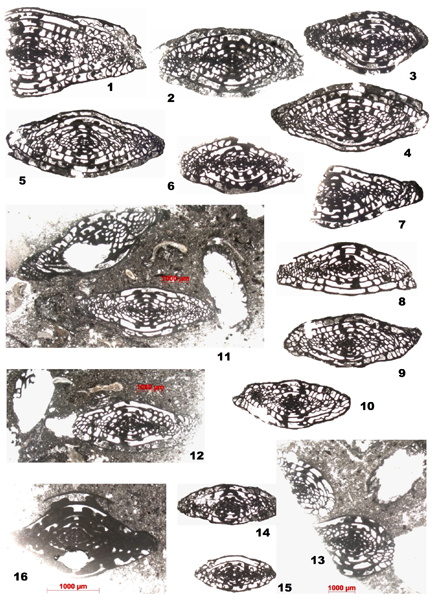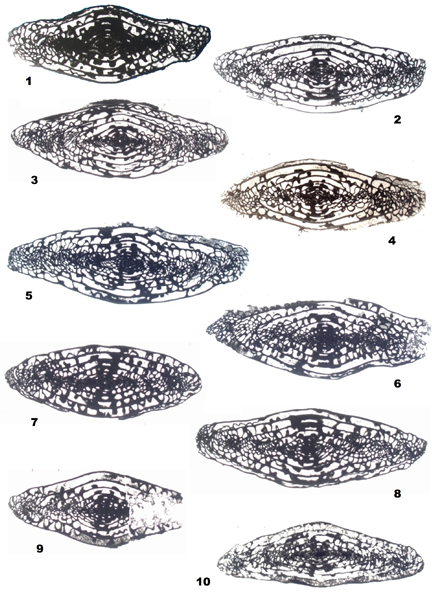Kansas Geological Survey, Current Research in Earth Sciences, Bulletin 258, part 4
Prev Page--Previous studies, Howe Limestone Member || Next Page--Assemblages
![]()
![]()
![]()
Kansas Geological Survey, Current Research in Earth Sciences, Bulletin 258, part 4
Prev Page--Previous studies, Howe Limestone Member ||
Next Page--Assemblages
![]()
Plate 1--Fusulinids from Locality 1. Figures 1-7--Leptotriticites glenensis Thompson, x10. Figures 8-15--Leptotriticites hughesensis Thompson, x10. Figure 16--Microspheric specimen of Leptotriticites sp., x25. Note that figs. 11, 12, and 13 show partially skelmoldic fusulinids (white areas) adjacent to preserved fusulinids. [Web note: please use the Acrobat PDF version for more accurate scaling of images.]

Plate 2--Fusulinids from Locality 2. Figure 1--Leptotriticites glenensis Thompson, x10. Figures 2-4--Leptotriticites wetherensis Thompson, x10. Figures 5-9--Leptotriticites hughesensis Thompson, x10. Figure 10--Leptotriticites gracilitatus Skinner, x10. [Web note: please use the Acrobat PDF version for more accurate scaling of images.]

Description: Specimens from our samples assigned to L. glenensis have a moderately large shell size and a relatively inflated fusiform shell shape, with distinct axial fillings, rather irregularly fluted septa, and massive chomata.
Occurrence: Fusulinids from our Howe Limestone Member samples that were assigned to L. glenensis were found in samples from both Localities 1 and 2. Leptotriticites glenensis was originally described by Thompson (1954) from the Glenrock Limestone Member of the Red Eagle Limestone. Wahlman and King (2002) reported L. aff. L. glenensis from the "Bursumian" interval in the Robledo Mountains of New Mexico. Recently Stevens and Stone (2007) also recognized L. glenensis in their latest Pennsylvanian Fusulinid Zone 2 in the Bird Spring Group of southeastern California.
Description: Specimens from the Howe Limestone Member samples assigned to L. wetherensis have a moderately large shell size, very light to no axial fillings, minor to no septal fluting in the central part of the test, and relatively small knob-like chomata.
Discussion: Most of the type specimens of this species illustrated by Thompson (1954, Pl. 23, figs. 5-14) from the Camp Creek Shale and Stockwether Limestone Members of the Pueblo Formation in north-central Texas had slightly inflated fusiform shell shapes, but he also illustrated a more elongate fusiform morphotype (Plate 23, fig. 10) that the Howe Limestone Member specimens more closely resemble.
Occurrence: Specimens assigned to this species from our Howe Limestone Member samples are from Locality 2. Leptotriticites wetherensis was described by Thompson (1954) from the Camp Creek Shale and Stockwether Limestone Members of the Pueblo Formation in north-central Texas. According to Darwin Boardman (March 2010, personal communication), conodont assemblages from the maximum flooding horizon in the lower part of the Stockwether Limestone Member suggest that it may be slightly younger than the Red Eagle Limestone of Kansas, and that the systemic boundary is probably in the underlying Camp Creek Shale Member interval. Recently Stevens and Stone (2007) recognized L. wetherensis in their Fusulinid Zone 2 of the Bird Spring Group of southeastern California.
Description: Several specimens from the Howe Limestone Member were assigned to this species because of their moderate shell size, elongate fusiform shell shape, tiny proloculus, axial fillings in the inner volutions, distinct chomata, and moderately developed and irregular septal fluting.
Occurrence: L. hughesensis was the most common species recognized from our Howe Limestone Member samples from both Localities 1 and 2. The specimens from Locality 1 are slightly smaller than those from Locality 2, which might be an ecophenotypic response to somewhat less hospitable paleoenvironmental conditions. This species was originally described by Thompson (1954) from the Hughes Creek Shale Member of the Foraker Limestone in Kansas, which underlies the Red Eagle Limestone. Wahlman and King (2002) reported L. hughesensis from the "Bursumian" interval in the Robledo Mountains of New Mexico. Recently Stevens and Stone (2007) recognized L. hughesensis in their Fusulinid Zones 2 and 3 of the Bird Spring Group of southeastern California, suggesting that the species ranges across the Carboniferous (Pennsylvanian)-Permian boundary in that area.
Occurrence: The single specimen assigned to this species occurred in the Howe Limestone Member at Locality 2. The species was originally described from the Big Hatchet Mountains of southeastern New Mexico by Skinner and Wilde (1965). On Wilde's (2006, fig. 5) fusulinid range chart for the Big Hatchet Mountains, the occurrence of L. gracilitatus is shown to be earliest Permian (early part of Nealian Substage). That occurrence matches well the earliest Nealian occurrence of the single Howe Limestone Member specimen. Wahlman and King (2002) reported L. aff. L. gracilitatus from the "Bursumian" interval in the Robledo Mountains of New Mexico.
Prev Page--Previous studies, Howe Limestone Member || Next Page--Assemblages
Kansas Geological Survey
Placed online Dec. 3, 2010; Revised Jan. 2011
http://www.kgs.ku.edu/Current/2010/Wahlman/04_paleo.html
email:webadmin@kgs.ku.edu